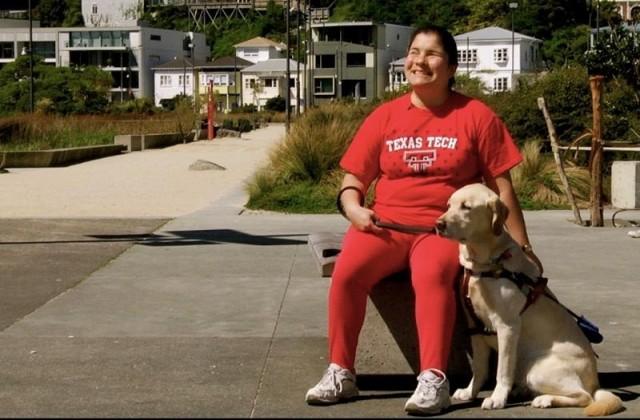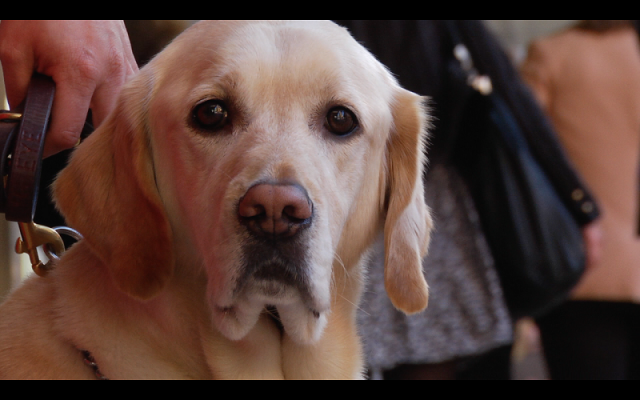Everything Pinoys need to know about assistance dogs
[Ed’s note: Norman Zafra is a journalist who took his postgraduate studies in Wellington New Zealand. He noticed the freedom and independence of blind and partially sighted persons, confidently and independently walking the streets…with their dogs. His interest in assistance dogs led him to research more about it as a class requirement. He made a short documentary about the two.]

Dogs have been a human companion since time immemorial. But there are more to dogs than pets. We all know about explosive-sniffing dogs, police or K-9 dogs and therapy dogs. But it seems like Filipinos are mostly unacquainted with assistance dogs, or working dogs for persons with disability or PWD.
These are no ordinary animals. Often identified with their coat, handle and harness, these dogs are widely trained to accompany and assist persons with disability, helping them live independently and increase their mobility.
I soon found myself exploring the world of 32-year-old Julia Mosen, who has been blind since birth but independently does ordinary tasks with her guide dog Kerry.
Julia migrated to New Zealand with Kerry in 2006 and since then lived in Wellington. I met her through the Association of Blind Citizens of New Zealand, and made a documentary about them.
Titled "A Friend in Sight", the story captures a day in the life of Julia and Kerry, revealing the extraordinary bonding between a blind person and a guide dog.
While filming, it was easy to notice the synchronicity of their movements. Kerry was well-behaved and responded faithfully to commands and hand signals from her handler. Wearing the harness, the dog was aware that she was on working mode.
Guide dogs (also called service or assistance animals) undergo long and rigorous training and Kerry takes her job to heart. She knows how to navigate public spaces, cross the road, turn corners and even take the stairs and elevators.
Surprisingly, she also knows how to find the counter at the mall and accompanies Julia to her regular music rehearsal.
At an early age, guide dogs are trained to get used to noisy surroundings including crowded streets.
“I trained with Kerry for a month before I got her. We started doing small routes in small quiet streets,” says Julia. “We were getting used to each other.”

Julia claims that guide dogs are not perfect and so the communication and signal between a handler and a dog are crucial especially in navigating public spaces.
“If we miss something because I am not paying attention to what she's doing or I misjudge a distance, yes we can still get lost and that does happen,” adds Julia.
Kerry was born and trained in The Seeing Eye, a US-based guide dog school.
New Zealand has a counterpart - a guide dog breeding and training center in Auckland managed by the Blind Foundation. This facility serves as a school where puppies are trained and later on matched with a blind or partially sighted.
Both The Seeing Eye and Blind Foundation are among the 93 guide dog schools worldwide accredited by the International Guide Dog Federation (IGDF). In Asia, only Japan, South Korea and Taiwan have guide dog schools accredited by IGDF. No guide dog school can be found in the Philippines.
The absence of a training center for assistance dogs in the Philippines is one reason why most Filipinos are relatively unaware about the existence of these working animals.
In 2014, a photo of a foreigner and his assistance dog quickly circulated on social media after the two were apparently denied entrance to a mall in Dumaguete.
Unaware of working dogs, the security guards initially insisted on the rule that pets are not allowed inside the mall premises.
The man in the photo was later on identified as Mark Cohen, a medically certified person with a neurological disorder.
His certified service dog named Happy is trained to respond to symptoms of his disability including epilepsy, Parkinsonism, sensitivity to light and temperature and sudden drop in blood pressure. The incident is arguably the first viral story involving a service dog in the Philippines.
Unknown to many, there are three types of assistance dogs, according to a coalition called Assistance Dogs International.
First is the guide dog for the blind and visually impaired (like Kerry).
Second is the hearing dog for the deaf and hard of hearing.
And third is the service dog for people with other physical, medical and psychiatric disabilities (like Happy).
Assistance dogs have a special pass to public spaces including restaurants, concert halls, malls, schools and public transport. In New Zealand for instance, the Human Rights Act of 1993 and the Dog Control Act of 1996 provide the blind or partially sighted with the same rights of access to a place or facility as any other citizens while accompanied by an assistance dog.
Despite having no training center in the Philippines for guide dogs, legislations have long been in place recognizing the accessibility rights of Filipinos with disability. Republic Act No. 7277 or the Magna Carta for Disabled Persons assures among others the self-reliance of PWDs and their integration into the mainstream society.
The law needs to be amended, however, to acknowledge the international rights of PWDs and grant them (both locals and foreigners) an access to public spaces while accompanied by their service dogs.
A few months from now, Kerry is finally retiring at the age of 9. But they say that once trained as a guide dog, she is expected that she will remain loyal and earnest in her purpose all throughout her life.
Watch the full documentary below:
— LA/KVD, GMA News



